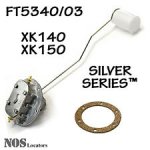I have installed a much larger alu fuel tank in a BN1 100/4. The fuel tank has a side fitted fuel sender which was copied from the jaguar XK140/150 fuel sender. It has two connectors (I believe one to measure the actual fuel level and the second for measuring the reserve tank which i don't have).
I have standard Smith's fuel dial. The two do not seem compatible !! Both the sender and the gauge are earthed and wired correctly. From both the top and bottom contact on the sender i am getting a full reading which I know is not the case as the fuel tank is near empty...
Do I need to find an alternative fuel gauge ?
Any help appreciated...

I have standard Smith's fuel dial. The two do not seem compatible !! Both the sender and the gauge are earthed and wired correctly. From both the top and bottom contact on the sender i am getting a full reading which I know is not the case as the fuel tank is near empty...
Do I need to find an alternative fuel gauge ?
Any help appreciated...


 Hi Guest!
Hi Guest!

 smilie in place of the real @
smilie in place of the real @
 Pretty Please - add it to our Events forum(s) and add to the calendar! >>
Pretty Please - add it to our Events forum(s) and add to the calendar! >> 

